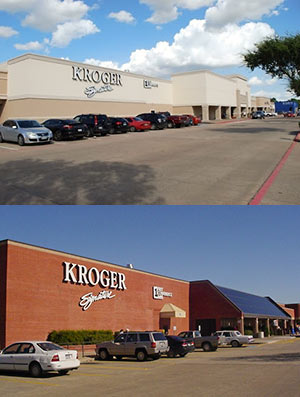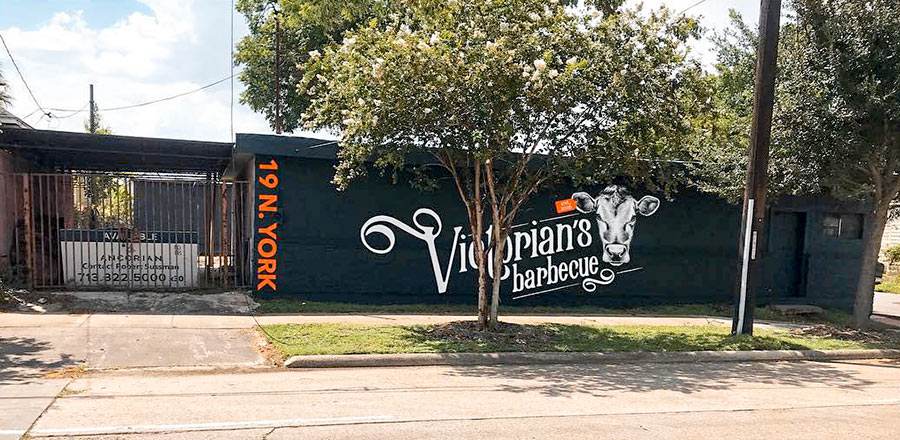WHAT HAPPENS WHEN YOU STUCCOAT A BRICK SHOPPING CENTER IN COPPERFIELD  It’s not exactly a stucco jacket — a marketing brochure for the redone Easton Commons Shopping Center at the intersection of Hwy. 6 and West Rd. in Copperfield indicates the new coating and foam cornice (pictured at top) on top of the old brick structures (pictured at bottom) are actually Dryvit, a brand of EIFS, or a way to get that stucco look without all the layers and labor. (It’s Oyster Shell #456 above and Monastery Brown #381 below, plus Lantana Cobble Texas Stone on the columns, if you’re keeping score at home.) But Real Estate Bisnow’s Catie Dixon says the new brick-hiding exercise for the shopping center is “paying off” for its landlord: “in the five months since beginning renovations at Easton Commons, NewQuest’s Josh Friedlander and team have brought on eight new tenants totaling nearly 33k SF.” Among the newcomers drawn to all that relieving smoothness: Pet Club, UFC Gym, Beauty Empire, West Oaks Music Studio, and FJ Liquor. NewQuest Epic Investments will be building up a few freestanding buildings in the center facing Hwy. 6, Dixon reports, to make room for a new Smashburger, Verts Kebap, and a third unnamed restaurant, possibly (the brochure indicates) a Corner Bakery. [Real Estate Bisnow; brochure (PDF)] Photos: Catie Dixon (after); LoopNet (before)
It’s not exactly a stucco jacket — a marketing brochure for the redone Easton Commons Shopping Center at the intersection of Hwy. 6 and West Rd. in Copperfield indicates the new coating and foam cornice (pictured at top) on top of the old brick structures (pictured at bottom) are actually Dryvit, a brand of EIFS, or a way to get that stucco look without all the layers and labor. (It’s Oyster Shell #456 above and Monastery Brown #381 below, plus Lantana Cobble Texas Stone on the columns, if you’re keeping score at home.) But Real Estate Bisnow’s Catie Dixon says the new brick-hiding exercise for the shopping center is “paying off” for its landlord: “in the five months since beginning renovations at Easton Commons, NewQuest’s Josh Friedlander and team have brought on eight new tenants totaling nearly 33k SF.” Among the newcomers drawn to all that relieving smoothness: Pet Club, UFC Gym, Beauty Empire, West Oaks Music Studio, and FJ Liquor. NewQuest Epic Investments will be building up a few freestanding buildings in the center facing Hwy. 6, Dixon reports, to make room for a new Smashburger, Verts Kebap, and a third unnamed restaurant, possibly (the brochure indicates) a Corner Bakery. [Real Estate Bisnow; brochure (PDF)] Photos: Catie Dixon (after); LoopNet (before)





EIFS alone will drive occupancy rates? I don’t get that. I need an expert to explain this to me.
How much would it cost to stuccoat the Astrodome?
I don’t think it’s the foam stucco that’s attracts tenants, but rather the idea that the center has been “modernized”. Fresh, new, shiny….it’s the prevalent mentality of restlessness that drives a lot of the economy in the form of buying new stuff because they’re tired of looking at something “old”.
They’ll be peeling that crap off of tons of building in the next 20-50 years. I think it’ll go down as one of the more scorned materials and styles of the early 21st century.
I live near this location. They have recently remodeled the inside of the store as well. I am glad to hear there are new tenants on the way. Much of this shopping center had been vacant for years.
The attraction of EIFS has never been in its appearance or it’s durability. It’s horrible on both fronts
.
EIFS is good for three reasons. First of all, of course, it’s cheap. But also, it helps insulate the building – which is very helpful if it’s an older, badly insulated building). And it’s light weight – there’s no need to beef up the structure and you can slap it right on top of brick veneer without too much worry.
.
So aside from making the retail center shiny and new, like Dana-X said, there are benefits to using EIFS. I just hope they didn’t use it below 8′-0″ above the sidewalk. I never will. I’ll put stone or something else that’s more durable where people can touch and feel it.
I never cared for this Kroger design of the 80’s, happy to see it updated. Kroger needs to do like HEB and hire a renouned architecture firm like Lake Flato to design their stores. They had better do something because HEB is really taking it to them.
EIFS is so gross. It gives structures a smothering, tight, moist hug.
Yeah, the problem with HEB is that they have a triple standard for their stores. New HEB stores in rich or suburban areas are nice. HEB stores in middle class urban areas are dirty, undersized, and have poor selection. And in working class neighborhoods, they don’t even call them HEBs. They’re Joe V’s, and they’re even smaller, dirtier, and have even worse selection than the in-town HEBs. It really shows who they think their customers should be….
.
Frankly I’d rather shop at Kroger, even if they use EIFS on their stores and didn’t hire Lake Flato. Or avoid them all and just buy our groceries at Super Target.
There’s a reason stores tend to look junky or dirty in poorer neighborhoods, most of the time it’s on purpose. There have been numerous studies done that dirtiness or disorganization inferres cheaper prices and better value (the most important thing to poorer shoppers).
—
Home Depot looks disorganized and like someone’s shed in the backyard on purpose vs Lowe’s which is organized and neat. The perception is that Home Depot is cheaper although on average Lowe’s is.
Kroger, HEB, Randalls…meh – I shop at Whole Foods…and get the rest of the “essentials” at Super Target…
You’re correct about HEB, but they’re now designing stylish stores in lower end markets. Kroger has ghetto stores as well, have you ever been in that dump in Eastwood?
And yeah, Target loves you and your debit/credit card and so does Hakeem in Nigeria. As for Whole Foods, it’s over priced and its “Austin” vibe is over rated.
I must suck at design (I do) as I thought the lower pic was the after. To me, the brick is way way better.
It’s sad that making this strip look like every other strip in town helped with occupancy. Kroger did need to get rid of that slanted glass greenhouse above the entrance, but the brick is actually refreshing today. LIke Dana-X said, in 20-50 years they’ll be pulling all of that foamcore mess off everything.
Oh my god, they destroyed the character of a shopping center whose vintage forty years from now would have been considered historical! How dare they. You bastards! What’s wrong with this city? But it’s in a part of town that I don’t like, so I’ll approach this rhetorically with a merely dubious slant about its economic efficacy. Wouldn’t want to lose any street cred over this. And now that bastard on Swamplot is mocking me. Well I’ll have you know buddy, that first they came for the Victorians and painted their colorful trim, and then they came for the bungalows and installed aluminum windows; and then they came for the row houses and did nothing to prevent their slow rotting away; and then they tried to install a vinyl fence across the street from me and I think its ugly and historically inaccurate and that it calls for a neighborhood committee, and IT WAS THE LAST STRAW; and now I’m speaking out for the mid-90’s grocery-anchored shopping centers because if I don’t, who will? Yeah, I’ll just anthropomorphize buildings and cast them as communists, socialists, unionists, or Jews in post-holocaustic light. Yeah, that’ll teach that sorry troll…
[/sarcasticrant]
They are remodeling their shopping center to signal cleanliness, affluence, security, and pretty much anything else that one might associate with newer construction in a part of town that isn’t already past its prime. It may unfortunately be a bit analogous and reminiscent of that Freakonomics chapter regarding how the lower class selects baby names, but yes, it bolsters the P&Ls for a period of time; to everything there is an economic life expectancy.
Don’t get me wrong. When H-E-B first came out with the Joe V’s concept, it intrigued me. I envisioned them putting Joe V’s stores in food deserts: the 5th Ward, Sunnyside, Acres Homes, and using tax credits to make them profitable. This is what they were suggesting they’d do when they announced the concept, but it’s not what actually happened. Joe V’s stores are being built in areas that are already well served by low-end grocers like Food Town and Fiesta. It seems clear to me that H-E-B was really just trying to get in on he low-end grocery market, while simultaneously elevating their H-E-B brand. It’s pretty sly, if you ask me.
.
That said, I’d love if they would stucco over one of the two Fiestas near my house. Inside and out! (Ok, maybe just new paint and fixtures on the inside and not stucco). (They can close the other). Those places are scary. I mean really, on the two times I’ve been into the one at Gessner and Braeswood, I’ve honestly been scared: and it’s two doors down from a Harris County Constables storefront in the same strip mall!
So is Joe V’s just HEB Pantry Foods rebranded? That’s what they used to call their shabby stores in less affluent neighborhoods, like the Heights in the 1980s.